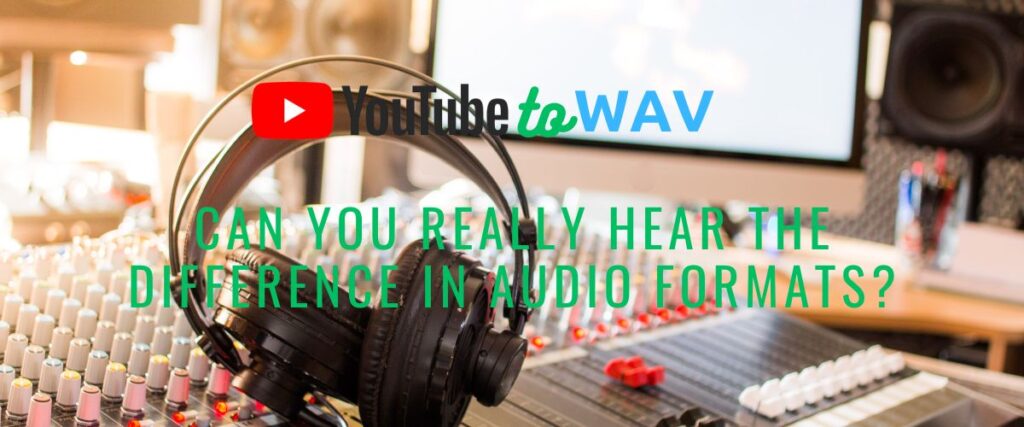Ever Wonder Can You Really Hear the Difference in Audio Formats? Yes, you can hear the difference in audio formats. Different formats affect the quality of sound produced.
The Science Behind Audio Formats
Discover the truth about audio formats and whether you can truly distinguish the difference between them. Dive into the science behind audio formats and the factors that may affect your perception of sound quality.
Analog Vs. Digital: Understanding The Basics
Audio formats play a crucial role in how we experience music today. Understanding the science behind these formats helps us appreciate the advancements made in the audio industry. When sound is transformed into digital signals, it goes through an intricate process. Analog signals, which are continuous and physical, need to be converted into digital signals, which are discrete and binary, for easy storage and manipulation. This conversion entails two main steps: sampling and quantization.
During sampling, the continuous sound wave is measured at various points and then discretized. Quantization assigns values to these discrete measurements, creating a digital representation of the sound. The common audio formats we encounter are MP3, WAV, and FLAC. MP3 is the most widely used format due to its high compression, while WAV and FLAC offer lossless formats for the preservation of audio fidelity. It is fascinating to explore the differences and similarities between these formats, especially considering the impact they have on our listening experience.
Common Audio Formats Explained
| Audio Format | Compression | Sound Quality | Uses |
|---|---|---|---|
| MP3 | Lossy (high compression) | Varies based on bitrate | Most common for online streaming and portable devices |
| WAV | Lossless | CD-quality audio | Preferred for professional audio editing |
| FLAC | Lossless | CD-quality audio | Perfect for audiophiles and archival purposes |

Debunking The Myths: Perception Vs. Reality
The debate around audio formats and their perceived differences often centers on perception versus reality. Our expectations play a powerful role in how we hear and interpret sound quality. It is essential to understand the influence of our own biases and perceptions when evaluating audio formats.
The Power Of Perception: How Expectations Influence Our Hearing
Studies have shown that our perception of sound can be heavily influenced by what we expect to hear. If we believe that a particular audio format is superior, we are more likely to perceive it as such regardless of any actual differences.
The Role Of Pseudoscience In The Audio Format Debate
Unfortunately, the audio format debate is not immune to pseudoscience. False claims and exaggerated marketing tactics can create misconceptions and confusion. It is important to approach the topic with a critical mindset, relying on scientific evidence rather than unsupported claims.
Misconceptions About High-resolution Audio
High-resolution audio is often heralded as the pinnacle of sound quality, but misconceptions abound. While it may offer benefits for professional mastering, the average listener may struggle to discern a noticeable difference compared to standard formats. Understanding the limitations and practicality of high-resolution audio is vital to avoid falling for misinformed marketing.
Conducting Listening Tests: What The Research Shows
In the world of audio formats, there has been an ongoing debate about whether there is a noticeable difference in sound quality between various formats. This debate has led to numerous controlled listening tests being conducted to determine whether people can actually hear the difference.
Researchers have carefully designed and conducted these tests to ensure accurate results. The tests involve playing audio clips in different formats to participants and having them compare the quality of each. The results from major audio format studies have been examined and critically analyzed.
Through these tests, it has been found that the majority of listeners cannot discern any significant difference between high-quality audio formats. This finding challenges the perception that certain formats inherently provide a superior listening experience. It suggests that factors such as individual preferences, biases, and expectations may have a greater influence on perceived audio quality.
Overall, the research shows that while there may be nuanced differences in audio formats, the ability of listeners to perceive these differences is limited. Therefore, the notion of a clear distinction between formats may be more of a subjective belief rather than an objective reality.
Factors Affecting Audio Quality
Audio quality is a subjective topic, but there are several factors that can affect the perception of sound fidelity. One important factor is the bitrate and compression of audio formats. When audio is compressed, it can result in a loss of quality. Higher bitrate formats, such as lossless audio, can offer a more accurate representation of the original recording.
Another factor that can impact audio quality is the equipment used for playback. High-end audio gear often has superior components and better amplification, resulting in enhanced sound reproduction. The quality of speakers or headphones, as well as the DAC (Digital-to-Analog Converter), can also have a significant effect on the listening experience.
Environmental factors also play a role in audio perception. Room acoustics can affect sound resonance and clarity, while background noise can mask subtle details in the audio. Creating an optimal listening environment with minimal background noise and proper acoustic treatment can help improve the overall audio quality.
Subjective Vs. Objective Audio Quality
When it comes to audio quality, the subjective listening experience plays a crucial role. Each individual has their own preferences and biases that can influence their perception of audio quality. Some may prefer the warm sound of vinyl records, while others may enjoy the convenience of digital formats. It’s important to recognize that subjective experiences may differ and what sounds pleasing to one person may not be the same for another.

On the other hand, objective measurement allows us to quantify audio quality using metrics. By analyzing factors like frequency response, signal-to-noise ratio, and total harmonic distortion, we can make objective assessments of audio quality. These metrics provide a standardized way to compare different audio formats and determine if there are any noticeable differences between them. However, it’s important to note that objective measurements may not fully capture the subjective listening experience.
Instead of focusing solely on subjective or objective approaches, a balance between the two can offer a more comprehensive understanding of audio quality. By considering both individual preferences and objective metrics, we can gain a deeper appreciation of the nuances in audio formats. This allows us to make more informed choices based on our personal preferences while acknowledging the importance of objective measurements.
The Future Of Audio Formats: Technological Advancements
The future of audio formats is constantly evolving, driven by technological advancements. One key area of development is the improvement of audio codecs and compression techniques. These play a crucial role in achieving higher sound fidelity while reducing file size for efficient distribution.
Immersive audio is another aspect that is gaining traction. It involves the exploration of 3D sound and spatial audio, creating a more realistic and captivating audio experience. This technology allows sound to be perceived from different directions, adding depth and dimension to the listening experience.
Furthermore, machine learning and artificial intelligence (AI) are revolutionizing audio quality. By analyzing vast amounts of data, AI can enhance audio by reducing noise, improving clarity, and enhancing overall sound reproduction. Machine learning algorithms can even learn from user preferences and adapt the audio output accordingly for a personalized experience.
With these advancements, the question of whether one can truly hear the difference in audio formats becomes more intriguing. The future holds great potential for audio enthusiasts to indulge in an immersive and high-quality audio experience.
Can You Really Hear the Difference in Audio Formats: Truth Or Fiction?
The debate surrounding audio formats and their impact on sound quality has been a topic of interest for both audiophiles and casual music listeners alike. Many claim to be able to hear a significant difference between various formats, such as high-resolution audio and compressed formats like MP3. However, scientific studies have shown mixed results, with some indicating that perception of audio quality is subjective and others suggesting that trained listeners can discern subtle differences between formats.
When it comes to everyday listening, the importance of audio formats becomes less significant for the average listener. While audiophiles may prefer high-resolution formats to capture every nuance of a recording, most people are perfectly content with the convenience and accessibility of compressed formats. In addition, music lovers recognize that the joy and emotion derived from music go beyond technical specifications, and can be experienced regardless of the format it is played in.
In conclusion, while there may be nuances in sound quality between different audio formats, the average listener may not be able to discern these differences or find them to be of paramount importance. Ultimately, the choice of audio format depends on individual preferences and priorities, with the most crucial factor being one’s enjoyment of the music itself.
FAQs on Can You Really Hear the Difference in Audio Formats?
Can you really hear the difference in audio formats?
Yes, the difference in audio formats can be heard, especially when comparing lossless formats like FLAC or WAV to lossy formats like MP3 or AAC.
What factors contribute to the difference in audio quality between formats?
The main factors that contribute to the difference in audio quality between formats are the compression algorithms used, the bit rate at which the audio is encoded, and the presence or absence of lossy compression.
Are lossless audio formats always better than lossy formats?
In terms of audio quality, lossless formats like FLAC or WAV are generally considered to be superior to lossy formats like MP3 or AAC. However, lossless formats also tend to have larger file sizes, which may not be ideal for certain storage or streaming situations.
How can I determine if I can hear the difference in audio formats?
One way to determine if you can hear the difference in audio formats is by conducting a blind listening test. This involves listening to the same audio content encoded in different formats without knowing which format is being played, and then trying to identify any audible differences.
Are there any specific types of audio content where the difference in formats is more noticeable?
The difference in audio formats is generally more noticeable in music with complex arrangements, rich instrumentation, and a wide dynamic range. Simple speech or low-quality recordings may not exhibit as significant a difference.
Are there any specific audio equipment requirements to accurately perceive the difference in formats?
To accurately perceive the difference in audio formats, it is recommended to use high-quality headphones or speakers that are capable of reproducing a wide frequency range and have good transient response. A well-calibrated audio setup can also help in discerning the differences.
Can the difference in audio formats be perceived by everyone?
Not everyone may be able to perceive the difference in audio formats, as it depends on individual hearing abilities, listening skills, and the quality of their audio equipment. However, many audiophiles and trained listeners can often detect the nuances between various formats.
Conclusion
To summarize, this blog post has tackled the age-old debate of whether individuals can truly discern the difference in audio formats. Through an exploration of various studies and expert opinions, it becomes evident that while some individuals may claim to hear variations, the majority of listeners struggle to distinguish between formats.
Ultimately, personal preference and subjective biases seem to play a more significant role in shaping perceptions of audio quality.

